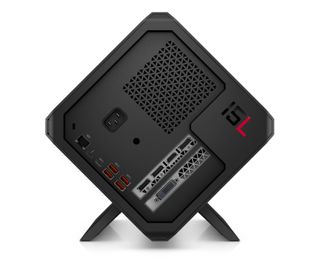HP Takes Aim At GPU Dock Market With The Omen Accelerator (Updated)

Updated 6-6-2017, 4:20PM CT: HP answered our request for more information and clarified the GPU and storage options available for the Omen Accelerator. The article has been changed to reflect this new information.
HP unveiled a new external graphics dock under the Omen gaming brand.
The Omen Accelerator is a Thunderbolt 3-powered eGPU enclosure that overrides the integrated or dedicated graphics of your HP-branded Thunderbolt 3-enabled laptop (or Ultrabook) to provide increased performance with a full-sized desktop GPU. HP wasn’t clear on whether or not the Omen Accelerator would work with other brands of Thunderbolt-certified notebooks, but we’d guess that the non-proprietary USB 3.1 Type-C connection makes it possible.
The Omen Accelerator can be configured with both Nvidia and AMD graphics cards, with HP offering an Nvidia GeForce GTX 1060, a GTX 1070, or an AMD Radeon RX580 in preconfigured models. A 500W PSU offers enough juice to accommodate up to an Nvidia GeForce GTX 1080, but HP confirmed that the Accelerator's power is divided between the GPU and the additional I/O, and that there's only 300W of juice available for the graphics card. Although you might be able to use a GTX 1080 in the Omen Accelerator, HP plays it safe by offering a slightly less power hungry GPU.
The PSU also provides 60W of power back to a connected PC via the USB 3.1 Type-C cable. If your device supports charging via USB-C, you won’t need to connect the notebook’s power adapter to keep your laptop or Ultrabook from using the battery. There’s also four USB 3.0 ports, in addition to an RJ45 connection for networking.

Unlike many other devices of its kind, the Omen Accelerator also houses a 2.5” drive bay, and HP will offer the Omen Accelerator with a 256GB SSD or 1TB HDD preinstalled. The company is even offering 5,400RPM and 7,200RPM HDDs. It will also be available sans storage and GPU if you want to add your own hardware, which HP claims is easy to do with the enclosure’s easy-access door.
HP entered the eGPU enclosure market at a time when almost everybody (see Galax, Razer, Gigabyte, Asus, Zotac) has or is about to release one. However, we’re impressed at HP’s take on the paradigm with the Omen Accelerator’s edgy red and black design and the inclusion of a 2.5” drive bay for additional storage.
Stay on the Cutting Edge
Join the experts who read Tom's Hardware for the inside track on enthusiast PC tech news — and have for over 25 years. We'll send breaking news and in-depth reviews of CPUs, GPUs, AI, maker hardware and more straight to your inbox.
HP is also firing shots at these other manufacturers by bringing the entry-level price for a Thunderbolt eGPU enclosure down to just $300 (for a barebones device, without storage or a GPU). If the Omen Accelerator turns out to be compatible with other brands of Thunderbolt 3-enabled devices (or even, say, a Macbook), then we predict that HP’s version of an external GPU dock will be a prime choice for value-oriented consumers looking to amp up their laptop’s graphics horsepower.
The Omen Accelerator external graphics enclosure will hit shelves this August, starting at $300.
-
Joel_75 The HP USB-C dock that I purchased is only usable on HP branded product so I wouldn't bet it could be used on anything else.Reply -
dark_lord69 I don't understand the market/need for an external GPU box.Reply
I know it's for laptops and I always thought something like this would be great but I was thinking like $50.
The cost of these devices are often more than a good video card... I'm not convinced that this would be any better than buying a discrete graphics card built into the laptop. I guess if a person had a laptop with an excellent CPU and onboard graphics then it might be worth it but your looking at $550 - $700... ..and that's enough for a whole new laptop... -
hitman400 Reply19786069 said:I don't understand the market/need for an external GPU box.
I know it's for laptops and I always thought something like this would be great but I was thinking like $50.
The cost of these devices are often more than a good video card... I'm not convinced that this would be any better than buying a discrete graphics card built into the laptop. I guess if a person had a laptop with an excellent CPU and onboard graphics then it might be worth it but your looking at $550 - $700... ..and that's enough for a whole new laptop...
The only added extra cost is $300 for an eGPU setup. The rest of the cost comes from buying the actual GPU. You can save money when getting a laptop by only buying an integrated GPU, so you aren't paying extra for a dGPU in a laptop as well.
Some benefits of an eGPU: allows your laptop to run cooler and quieter, prolonging life. Allows you to achieve power and portability (not simultaneously). Honestly, I think it is counter intuitive buying a laptop with a dedicated GPU because it is automatically obsolete as soon as you get it.
Also, I think it is a bad move on HP to only capture the market for HP consumers. Why is Alienware and HP fragmenting the eGPU consumer base to only their products.
-
Jack_275 @Dark_Lord personally I see it for the ultraportable class especially i.e. the Hp spectres that weigh just a couple pound and cost around $1500 for high end models, now you have everything set up just plug and play any high end game, no need to duplicate files, subscriptions etc. To get a gaming pc with a 1070, i7, cooling, motherboard, and a high quality screen your looking closer to 2000 with a nice monitor much much than the 600-700 needed for the same setup with this.Reply
Most Popular




